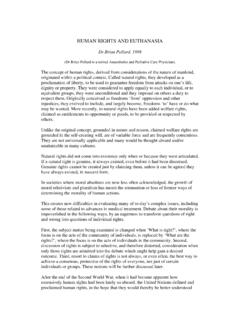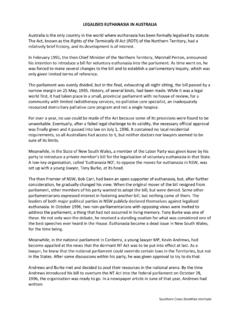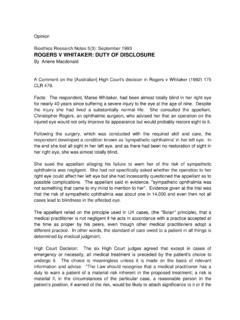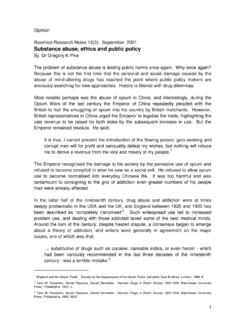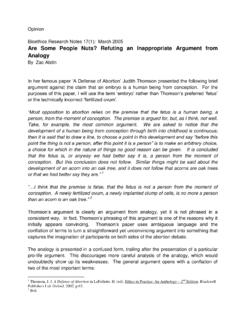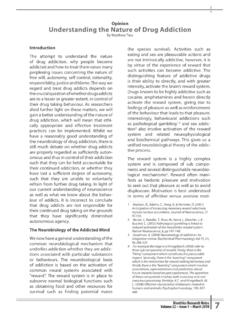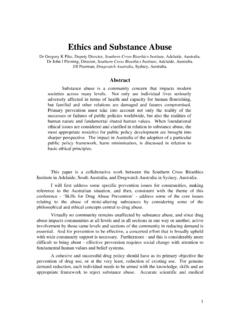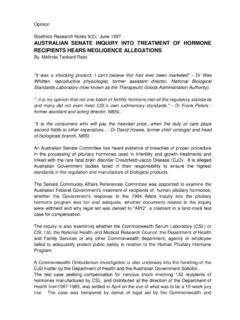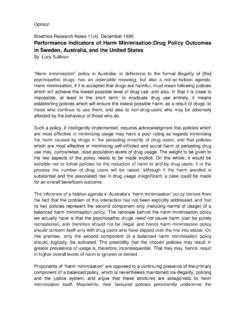Transcription of Euthanasia today and euthanasia in Nazi Germany ...
1 Opinion Bioethics Research Notes 12(1): March 2000 Euthanasia today and Euthanasia in nazi Germany similarities and dissimilarities By Dr John I Fleming The continuing debate on Euthanasia in Western countries has frequently brought with it comparisons with the nazi Euthanasia experiment in the 1930s and 40s. Opponents of legalised voluntary Euthanasia have sometimes made simplistic comparisons between the Holocaust and the contemporary proposals for assisted suicide and voluntary Euthanasia to be legalised. On the other hand proponents of such law reform have expressed outrage at any suggestion that their proposals have anything in common with coerced Euthanasia and racism which, they say, were the only issues in nazi Germany .
2 In any case, they say, voluntary Euthanasia was never legalised in nazi Germany . The facts, however, do indicate official toleration of both voluntary Euthanasia and non-voluntary Euthanasia which amounted to legalisation. How was this so? The key is the power that Hitler exercised over the Third Reich such that the Reichstag (the elected Parliament) meekly agreed to a law which effectively made itself irrelevant as a law-making body. On March 23, 1933 the Reichstag convened to consider the Law for Removing the Distress of People and Reich . In this Act most of the power of legislation was taken away from the Parliament and put into the hands of the Reich cabinet for a period of four On January 30, 1934 Hitler completed the task by means of a Law for the Reconstruction of the Reich.
3 Popular assemblies of the states were abolished, the sovereign powers of the states were transferred to the Reich, all state governments were placed under the Reich government and the state governors put under the administration of the Reich Minister of the Interior. 2 By July 14 the nazi Party ruled supreme and a law decreed: The National Socialist German Workers Party constitutes the only political party in Germany . Whoever undertakes to maintain the organizational structure of another political party or to form a new political party will be punished ..3 Thus, as William L Shirer has observed, the one-party totalitarian State had been achieved with scarcely a ripple of opposition or defiance, and within four months after 1 William L Shirer, The Rise and Fall of the Third Reich, (London: Pan Books, 1960), 248 2 Ibid.
4 , 250-251 3 National Conspiracy and Aggression (part of the Nuremberg documents), III, page 962 (ND 1388-PS) the Reichstag had abdicated its democratic responsibilities .4 Indeed, Hitler would always say that he achieved totalitarian rule by democratic means. So much did Hitler have control over the Third Reich and the German peoples that on April 26, 1942 he had his rubber stamp Reichstag pass a law which gave him absolute power of life and death over every German and simply suspended any laws which might stand in the way of this. 5 Here is an extract from that law: In the present war, in which the German people are faced with a struggle for their existence or their annihilation, the Fuehrer must have all the rights postulated by him which serve to further or achieve victory.
5 Therefore - without being bound by existing legal regulations - in his capacity as Leader of the nation, Supreme Commander of the Armed Forces, Head of Government and supreme executive chief, as Supreme Justice and Leader of the Party - the Fuehrer must be in a position to force with all means at his disposal every German, if necessary, whether he be a common soldier or officer, low or high official or judge, leading or subordinate official of the party, worker or employer - to fulfil his duties. In case of violation of these duties, the Fuehrer is entitled after conscientious examination, regardless of so-called well-deserved rights, to mete out due punishment and to remove the offender from his post, rank and position without introducing prescribed The fact of the matter is that in the Third Reich the procedures for deciding policy and implementing policy were very different from our own.
6 But it did have the force of law. The policies of the Party, and especially of the F hrer, were in and of themselves law. How did all of this affect Euthanasia ? In nazi Germany Euthanasia was implemented as a strictly medical measure justified by racial biology. During the autumn of 1940 a law legalizing Euthanasia was discussed .. but it was never implemented. 7 Revised drafts of the law did the rounds but it never went beyond the final draft. Although consideration was given to Euthanasia legislation it was never finally proceeded with or promulgated by decree. Hitler killed the project on the grounds that it would fuel enemy propaganda. Some suspect that the real reason why the law never materialised was that the pedantic scrupulosity of its provisions would have slowed the momentum of the nazi killing programme by substituting expertise, precision and normative processes for procedures hitherto based on the broad, arbitrary 4 William L Shirer, op.
7 Cit., 252 5 William L Shirer, op. cit., 1036 6 National Conspiracy and Aggression (part of the Nuremberg documents), V, page 565 (Nuremberg document 2896-PS) 7 Paul Weindling, Health, race and German politics between national unification and Nazism 1870-1945, (Cambridge: Cambridge University Press, 1989) 548 8 Michael Burleigh, Death and Deliverance, (Cambridge: Cambridge University Press, 1994), 172 The fact is that the Euthanasia programme was regarded by many as legal in so far as it implemented the policies of the regime. Indeed the defence of the German doctors at Nuremberg was that they did no wrong because they merely obeyed the lawful command of the state. Did the Euthanasia programme include voluntary Euthanasia ? The answer is, probably yes.
8 For example, in August 1939 a Ministry of Justice commission on the reform of the criminal code provided the KdF (Chancellory of the F hrer, Kanzlei des F hrers) with a draft law to legalise Euthanasia . As Michael Burleigh has put it: Having proposed the decriminalization of voluntary Euthanasia , the lawyers blithely dovetailed this with the involuntary killing of psychiatric patients .9 Clause 1. Whoever is suffering from an incurable or terminal illness which is a major burden to himself or others, can request mercy killing by a doctor, provided it is his express wish and has the approval of a specially empowered doctor. Clause 2. The life of a person who because of incurable mental illness requires permanent institutionalisation and is not able to sustain an independent existence, may be prematurely terminated by medical measures in a painless and covert The killings of the psychiatrically ill and children deemed to be deformed followed logically from the proposition that there was life not worthy to be lived and which could be ended at the patient s request.
9 In the end, there was no law which passed the Reichstag which provided for Euthanasia in any form. The point is, however, that Euthanasia was the policy of the lawful government of the Third Reich, policy which itself had the effect of law. The German doctors were thus able to plead that they did no wrong when they killed psychiatric patients and Jews because they merely obeyed the lawful command of the State. It would seem unlikely that the Nazis would baulk at voluntary Euthanasia given their commitment to coercive forms of Euthanasia . Moreover, the evidence of the Ministry of Justice commission s draft law cited above makes the connection between the two explicit. In the contemporary bioethical literature it is interesting to note how the discussion of Euthanasia moves quickly from voluntary Euthanasia to various forms of non-voluntary Euthanasia .
10 Non-voluntary killings almost always begin with proposing the infanticide of newborns with disabilities. Similarly in the Third Reich these children were the first targets of the Euthanasia programme. 9 Ibid., 99 10 Karl-Heinz Roth and G tz Aly, Das Gesetz die Sterbehilfe bei unheilbar Kranken:. Protokolle de Diskussion ber die Legalisierung der nationalsozialistischen Anstaltsmorde in den Jahren 1938-1941 , in Roth (ed.), Erfassung zur Vernichtung, 108 and cited in Michael Burleigh, op. cit., 99 What distinguishes the Third Reich in its many infamies is the directing of Euthanasia against a whole race of people, the Jews. In this important and crucial sense Euthanasia in the Third Reich has to be seen as something completely different from anything proposed by modern day supporters of non-voluntary Euthanasia .
